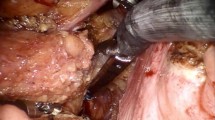Abstract
Minimally invasive surgery for total mesorectal excision (TME) remains technically challenging due to poor maneuverability within the pelvis, which makes extremely difficult to introduce a laparoscopic stapler (LS) for the rectal transection. We aim to perform a systematic review and meta-analysis on robotic TME after the use of robotic stapler (RS) or LS after robotic TME. A systematic literature search was performed using PubMed, MEDLINE, and Cochrane Database. Participants who underwent robotic anterior resection were considered following these criteria: (1) studies comparing RS and LS; (2) studies reporting the rate of anastomotic leakage (AL). The primary outcome was the risk of AL. Secondary outcomes included the number of firings of stapler needed. A meta-analysis based on Preferred Reporting Items for Systematic Reviews and Meta-analyses (PRISMA) statement was performed. A total of 4 studies including 391 patients (LS = 251, RS = 140) were included for analysis. Regarding the number of firings, overall results suggest that the rectal stapling was achieved with less firings in the RS group, but the difference is not significant [risk difference, (95% CI) 0.42 (− 0.13, 0.97)]. There was a 56% increased odds of AL for LS compared with RS; however, this was not statistically significant (OR: 1.56; 95% CI 0.59, 4.14). With the current literature evidence, the present study could not demonstrate a clear benefit of the RS over the LS. Although the development of an AL is multifactorial and unpredictable, our data may suggest that the use of the RS could help reducing the risk of AL. There is a need of future randomized clinical trial to assess the possible benefits of the RS.



Similar content being viewed by others
References
Jamali FR, Soweid AM, Dimassi H, Bailey C, Leroy J, Marescaux J (2008) Evaluating the degree of difficulty of laparoscopic colorectal surgery. Arch Surg (Chicago, Ill : 1960) 143(8):762–767. https://doi.org/10.1001/archsurg.143.8.762
Park JS, Choi GS, Kim SH, Kim HR, Kim NK, Lee KY, Kang SB, Kim JY, Lee KY, Kim BC, Bae BN, Son GM, Lee SI, Kang H (2013) Multicenter analysis of risk factors for anastomotic leakage after laparoscopic rectal cancer excision: the Korean laparoscopic colorectal surgery study group. Ann Surg 257(4):665–671. https://doi.org/10.1097/SLA.0b013e31827b8ed9
Braunschmid T, Hartig N, Baumann L, Dauser B, Herbst F (2017) Influence of multiple stapler firings used for rectal division on colorectal anastomotic leak rate. Surg Endosc 31(12):5318–5326. https://doi.org/10.1007/s00464-017-5611-0
Qu H, Liu Y, Bi DS (2015) Clinical risk factors for anastomotic leakage after laparoscopic anterior resection for rectal cancer: a systematic review and meta-analysis. Surg Endosc 29(12):3608–3617. https://doi.org/10.1007/s00464-015-4117-x
Kawada K, Sakai Y (2016) Preoperative, intraoperative and postoperative risk factors for anastomotic leakage after laparoscopic low anterior resection with double stapling technique anastomosis. World J Gastroenterol 22(25):5718–5727. https://doi.org/10.3748/wjg.v22.i25.5718
Priatno E, Kim SH (2015) Single stage robotic total mesorectal excision-a stepwise approach. J Vis Surg 1:24. https://doi.org/10.3978/j.issn.2221-2965.2015.12.02
Leong QM, Son DN, Cho JS, Amar AH, Kim SH (2012) Robot-assisted low anterior resection for situs inversus totalis: a novel technical approach for an uncommon condition. Surg Laparosc Endosc Percutaneous Tech 22(2):e87–90. https://doi.org/10.1097/SLE.0b013e3182447ebc
Lightner AL, Kelley SR, Larson DW (2018) Robotic Platform for an IPAA. Dis Colon Rectum 61(7):869–874. https://doi.org/10.1097/dcr.0000000000001125
Johnson CS, Kassir A, Marx DS, Soliman MK (2019) Performance of da Vinci Stapler during robotic-assisted right colectomy with intracorporeal anastomosis. J Robot Surg 13(1):115–119. https://doi.org/10.1007/s11701-018-0828-z
Ramos JR, Parra-Davila E (2014) Four-arm single docking full robotic surgery for low rectal cancer: technique standardization. Rev Colegio Brasil Cir 41(3):216–223
Holzmacher JL, Luka S, Aziz M, Amdur RL, Agarwal S, Obias V (2017) The use of robotic and laparoscopic surgical stapling devices during minimally invasive colon and rectal surgery: a comparison. J Laparoendosc Adv Surg Tech Part A 27(2):151–155. https://doi.org/10.1089/lap.2016.0409
Koh FH, Tan KK, Lieske B, Tsang ML, Tsang CB, Koh DC (2014) Endowrist versus wrist: a case-controlled study comparing robotic versus hand-assisted laparoscopic surgery for rectal cancer. Surg Laparosc Endosc Percutaneous Tech 24(5):452–456. https://doi.org/10.1097/SLE.0b013e318290158d
Guadagni S, Di Franco G, Gianardi D, Palmeri M, Ceccarelli C, Bianchini M, Furbetta N, Caprili G, D’Isidoro C, Moglia A, Melfi F, Buccianti P, Mosca F, Morelli L (2018) Control comparison of the new endowrist and traditional laparoscopic staplers for anterior rectal resection with the Da Vinci Xi: a Case Study. J Laparoendosc Adv Surg Tech Part A. https://doi.org/10.1089/lap.2018.0218
Tejedor P, Sagias F, Nock D, Flashman K, Naqvi S, Kandala NL, Khan JS (2019) Advantages of using a robotic stapler in rectal cancer surgery. J Robot Surg. https://doi.org/10.1007/s11701-019-00993-4
Atasoy D, Aytac E, Ozben V, Bayraktar O, Erenler Bayraktar I, Aghayeva A, Baca B, Hamzaoglu I, Karahasanoglu T (2018) Robotic versus laparoscopic stapler use for rectal transection in robotic surgery for cancer. J Laparoendosc Adv Surg Tech Part A 28(5):501–505. https://doi.org/10.1089/lap.2017.0545
Funding
No funding.
Author information
Authors and Affiliations
Contributions
All authors critically revised the paper for important intellectual content. All authors have contributed to the work and agreed on the final version. This manuscript is not being considered by any other journal.
Corresponding author
Ethics declarations
Conflict of interest
Authors have no conflict of interest.
Ethical approval
All procedures performed in studies involving humans were in accordance with ethical standards of the institutional research committee and the 1964 Helsinki declaration and its later amendments.
Informed consent
Informed consent was obtained from all participants.
Additional information
Publisher's Note
Springer Nature remains neutral with regard to jurisdictional claims in published maps and institutional affiliations.
Rights and permissions
About this article
Cite this article
Tejedor, P., Sagias, F., Flashman, K. et al. The use of robotic or laparoscopic stapler in rectal cancer surgery: a systematic review and meta-analysis. J Robotic Surg 14, 829–833 (2020). https://doi.org/10.1007/s11701-020-01126-y
Received:
Accepted:
Published:
Issue Date:
DOI: https://doi.org/10.1007/s11701-020-01126-y




